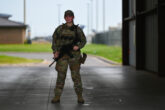July 16, 2014
Getting Unmanned Naval Aviation Right
The issue of when and how the U.S. Armed Forces fully integrate unmanned and increasingly autonomous surveillance and strike platforms into their inventory is one of the most important issues facing the Department of Defense. The Navy’s unmanned carrier-launched airborne surveillance and strike (UCLASS) program offers a test case to judge how serious the services are about ensuring carrier-based long-range strike missions in a contested environment. We are concerned that the Navy’s path to UCLASS aims too low, missing an opportunity to secure the future relevance of the carrier force, America’s primary forward-deployed, power-projection capability.
There are essentially two competing options for the unmanned system: a semi-stealthy aircraft with sufficient endurance to provide intelligence, surveillance, and reconnaissance (ISR) and light strike in largely permissive environments; or a more capable aircraft with air-to-air refueling capability designed to operate in contested airspace for surveillance and strike missions.
Open source reporting indicates that the request for proposals is biased toward the first option: an unmanned ISR aircraft capability. This is a questionable decision given the ability of other Navy platforms to perform this mission, including the P-8 Poseidon, the MQ-4C Triton, the MQ-8C Fire Scout, and the E-2D Advanced Hawkeye. This flies in the face of authoritative guidance, including the 2012 Defense Strategic Guidance, which directed the DoD to “invest as required to ensure its ability to operate in anti-access and area denial (A2/AD) environments.” Secretary of the Navy Ray Mabus also weighed in, writing at War on the Rocks in January of 2014 that “the end state (for UCLASS) is an autonomous aircraft capable of precision strike in a contested environment … It will be a warfighting machine.”
More from CNAS
-
National Security Human Capital Program
Short SupplyExecutive Summary The U.S. military faces a critical challenge: Fewer young Americans are willing to serve, and fewer adults are encouraging them to do so. Because of delibera...
By Katherine L. Kuzminski & Taren Sylvester
-
National Security Human Capital Program
Defending the Army’s Command Assessment ProgramThe concept for CAP — developed during the first Trump administration — benefited from the guidance, input and oversight from the foremost scholar and practitioner on military...
By Katherine L. Kuzminski
-
National Security Human Capital Program
‘Women Don’t Just Achieve…They Excel’: Fmr. Marine Corps Attack PilotDr. Kyleanne Hunter, former Marine Corps attack pilot and CEO of Iraq & Afghanistan Veterans of America, says “women are the fastest growing group of veterans” and “the fastes...
By Dr. Kyleanne Hunter
-
National Security Human Capital Program
A Workforce Strategy for America’s Shipbuilding FutureThe future of American maritime dominance will not be determined solely by the number of ships launched or contracts signed, but rather by the strength and sustainability of t...
By Katherine L. Kuzminski & Laura Schmiegel




